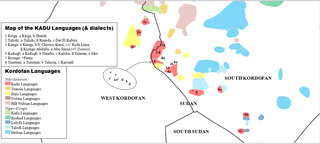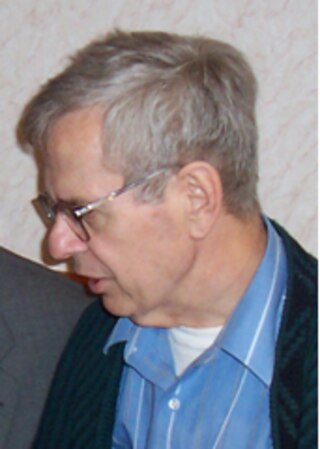Related Research Articles

The Afroasiatic languages, also known as Hamito-Semitic or Semito-Hamitic, are a language family of about 400 languages spoken predominantly in West Asia, North Africa, the Horn of Africa, and parts of the Sahara and Sahel. Over 500 million people are native speakers of an Afroasiatic language, constituting the fourth-largest language family after Indo-European, Sino-Tibetan, and Niger–Congo. Most linguists divide the family into six branches: Berber, Chadic, Cushitic, Egyptian, Semitic, and Omotic. The vast majority of Afroasiatic languages are considered indigenous to the African continent, including all those not belonging to the Semitic branch.

The Cushitic languages are a branch of the Afroasiatic language family. They are spoken primarily in the Horn of Africa, with minorities speaking Cushitic languages to the north in Egypt and Sudan, and to the south in Kenya and Tanzania. As of 2012, the Cushitic languages with over one million speakers were Oromo, Somali, Beja, Afar, Hadiyya, Kambaata, and Sidama.
The Omotic languages are a group of languages spoken in southwestern Ethiopia, in the Omo River region and southeastern Sudan in Blue Nile State. The Geʽez script is used to write some of the Omotic languages, the Latin script for some others. They are fairly agglutinative and have complex tonal systems. The languages have around 7.9 million speakers. The group is generally classified as belonging to the Afroasiatic language family, but this is disputed by some linguists.
Beja is an Afroasiatic language of the Cushitic branch spoken on the western coast of the Red Sea by the Beja people. Its speakers inhabit parts of Egypt, Sudan and Eritrea. In 2022 there were 2,550,000 Beja speakers in Sudan, and 121,000 Beja speakers in Eritrea according to Ethnologue. As of 2023 there are an estimated 88,000 Beja speakers in Egypt. The total number of speakers in all three countries is 2,759,000.
Ongota is a moribund language of southwest Ethiopia. UNESCO reported in 2012 that out of a total ethnic population of 115, only 12 elderly native speakers remained, the rest of their small village on the west bank of the Weito River having adopted the Tsamai language instead. The default word order is subject–object–verb. The classification of the language is obscure.
The South Cushitic or Rift languages of Tanzania are a branch of the Cushitic languages. The most numerous is Iraqw, with one million speakers. Scholars believe that these languages were spoken by Southern Cushitic agro-pastoralists from Ethiopia, who began migrating southward into the Great Rift Valley in the third millennium BC.

The Kadu languages, also known as Kadugli–Krongo or Tumtum, are a small language family of the Kordofanian geographic grouping, once included in Niger–Congo. However, since Thilo Schadeberg (1981), Kadu is widely seen as Nilo-Saharan. Evidence for a Niger-Congo affiliation is rejected, and a Nilo-Saharan relationship is controversial. A conservative classification would treat the Kadu languages as an independent family.
Proto-Afroasiatic (PAA), also known as Proto-Hamito-Semitic, Proto-Semito-Hamitic, and Proto-Afrasian, is the reconstructed proto-language from which all modern Afroasiatic languages are descended. Though estimations vary widely, it is believed by scholars to have been spoken as a single language around 12,000 to 18,000 years ago, that is, between 16,000 and 10,000 BC. Although no consensus exists as to the location of the Afroasiatic homeland, the putative homeland of Proto-Afroasiatic speakers, the majority of scholars agree that it was located within a region of Northeast Africa.

The languages of Ethiopia include the official languages of Ethiopia, its national and regional languages, and a large number of minority languages, as well as foreign languages.

Marvin Lionel Bender was an American linguist.
Daasanach is a Cushitic language spoken by the Daasanach in Ethiopia, South Sudan and Kenya whose homeland is along the Lower Omo River and on the shores of Lake Turkana.
Alagwa (Alaagwa’isa) is a Cushitic language spoken in Tanzania in the Dodoma region. Some Alagwa have shifted to other languages such as Sandawe.
The Aroid or Ari-Banna languages possibly belong to the Afro-Asiatic family and are spoken in Ethiopia.

Aweer (Aweera), also known as Boni, is a Cushitic language of Eastern Kenya. The Aweer people, known by the arguably derogatory exonym Boni, are historically a hunter-gatherer people, traditionally subsisting on hunting, gathering, and collecting honey. Their ancestral lands range along the Kenyan coast from the Lamu and Ijara Districts into Southern Somalia's Badaade District.
Dizin is an Omotic language of the Afro-Asiatic language family spoken by the Dizi people, primarily in the Maji woreda of the Southern Nations, Nationalities and Peoples Region, located in southwestern Ethiopia. The 2007 census listed 33,927 speakers. A population of 17,583 was identified as monolinguals in 1994.
David Appleyard is a British academic and an specialist in Ethiopian languages and linguistics.

The Proto-Afroasiatic homeland is the hypothetical place where speakers of the Proto-Afroasiatic language lived in a single linguistic community, or complex of communities, before this original language dispersed geographically and divided into separate distinct languages. Afroasiatic languages are today mostly distributed in parts of Africa, and Western Asia.

Azeb Amha is an Ethiopian linguist working on the morphology and syntax of Afroasiatic languages, with a special focus on Omotic languages. A senior researcher at the African Studies Center Leiden, Azeb is co-editor of the international Journal of African Languages and Linguistics and member of the board of the Dutch Society for African Studies (NVAS).
Grover M. Hudson was an American linguist and Professor Emeritus of Linguistics, Germanic, Slavic, Asian and African Languages at Michigan State University. He was known for his works on the Amharic language.
Proto-Cushitic is the reconstructed proto-language common ancestor of the Cushitic language family. Its words and roots are not directly attested in any written works, but have been reconstructed through the comparative method, which finds regular similarities between languages not explained by coincidence or word-borrowing, and extrapolates ancient forms from these similarities.
References
- Appleyard, David. 1989. The relative verb in focus constructions: an Ethiopian areal feature. Journal of Semitic Studies 34(2): 291-305.
- Appleyard, David. 2001. The verb 'to say' as a verb "recycling device" in Ethiopian languages. New Data and New Methods in Afroasiatic Linguistics: Robert Hetzron, in Memoriam, Andrzej Zaborski, ed., 1-11. Wiesbaden: Harrassowitz.
- Breeze, Mary. 1988. Phonological features of Gimira and Dizi. In Marianne Bechhaus-Gerst and Fritz Serzisko (eds.), Cushitic - Omotic: papers from the International Symposium on Cushitic and Omotic languages, Cologne, January 6–9, 1986, 473-487. Hamburg: Helmut Buske Verlag.
- Cohen, D., M.-C. Simeone-Senelle and M. Vanhove. 2002. The grammaticalization of 'say' and 'do': An areal phenomenon in East Africa. In T. Güldemann and M. V. Rocador, eds., Reported discourse: a Meeting ground for different linguistic domains, 227-251. Amsterdam / Philadelphia: John Benjamins.
- Crass, Joachim. 2002. Ejectives and pharyngeal fricatives: Two features of the Ethiopian language area. Ethiopian Studies at the end of the second millennium. Proceedings of the XIVth International Conference of Ethiopian Studies, November 6–11, 2000, Addis Ababa, ed. by Baye Yimam, Richard Pankhurst, David Chapple, Yonas Admassu, Alula Pankhurst, and Berhanu Teferra, 1679–1691. Addis Ababa: Institute of Ethiopian Studies.
- Crass, Joachim and Ronny Meyer (eds.). 2007. Deictics, Copula and Focus in the Ethiopian Convergence Area. (Afrikanistische Forschungen Band XV). Köln: Rüdiger Köppe. ISBN 978-3-89645-293-1
- Crass, Joachim and Ronny Meyer (eds.). 2009. Language contact and language change in Ethiopia. Köln: Rüdiger Köppe.
- Ferguson, Charles. 1970. The Ethiopian Language Area. The Journal of Ethiopian Studies 8.2: 67-80.
- Ferguson, Charles. 1976. The Ethiopian Language Area. Language in Ethiopia, ed. by M. Lionel Bender, J. Donald Bowen, Robert Cooper, Charles Ferguson, pp. 63–76. Oxford University Press.
- Güldemann, Tom. 2005. Complex predicates based on generic auxiliaries as an areal feature in Northeast Africa. Studies in African linguistic typology, ed. by F. K. Erhard Voeltz, 131-154. Amsterdam/Philadelphia: John Benjamins.
- Hayward, Richard J. 1991. Á propos patterns of lexicalization in the Ethiopian Language Area. In Daniela Mendel and Ulrike Claudi, Ägypten im afroorientalischen Kontext. Special issue of Afrikanistische Arbeitspapiere. Cologne: Institute of African Studies, pp. 139–56.
- Hayward Richard J. 2000. "Is There a Metric for Convergence." In Colin Renfrew, April McMahon and Larry Trask (eds) Time Depth in Historical Linguistics Vol 2 (Papers in the Prehistory of Languages), 621-640. Cambridge: The McDonald Institute for Archaeological Research.
- Meyer, Ronny, 2005. Riddles as indicator of cultural and linguistic convergence in the Gurage region: Ethiopia as language and cultural area. Scrinium 1:174-196.
- Rapold, Christian J., and Sylvia Zaugg-Coretti. "Exploring the periphery of the Central Ethiopian linguistic area: data from Yemsa and Benchnon." In Language contact and language change in Ethiopia, pp. 59-81. Köppe, 2009.
- Sasse, Hans-Jürgen. 1986. A Southwest Ethiopian Language area and its cultural background. In The Fergusonian Impact, vol. 1: From Phonology to Society, ed. by Joshua A. Fishman et al., pp. 327–342. Berlin: Mouton de Gruyter.
- Tosco, Mauro. 1994. On Case Marking in the Ethiopian Language Area (with special reference to subject marking in East Cushitic), Sem Cam Iafet. Atti della 7ª Giornata di Studi Camito-Semitici e Indeuropei (Milano, 1° giugno 1993). In Vermondo Brugnatelli (a cura di), 225-244. Milano: Centro Studi Camito-Semitici.
- Tosco, Mauro. 1994. The historical syntax of East Cushitic: A first sketch. Perspektiven afrikanistischer Forschung, ed. by Thomas Bearth, Wilhelm J.G Möhlig, Beat Sottas, Edgar Suter, pp. 415–440. Köln: Rüdiger Köppe.
- Tosco, Mauro. 2000. Is there an Ethiopian Language Area? Anthropological Linguistics 42:329-365.
- Treis, Yvonne. 2010. Perception verbs and taste adjectives in Kambaata and beyond. In Anne Storch, (ed.), Perception of the Invisible. Religion, Historical Semantics and the Role of Perceptive Verbs (SUGIA – Sprache und Geschichte in Afrika, 21) Cologne: Köppe. pp. 313–346. Article online
- Wedekind, Klaus. 1989. Status and dynamics of Ethiopian vowel systems. Journal of Ethiopian Studies 22: 105-136.
- Wu Tong. 2012. 2012. Prenominal relative clauses in Ethiopian languages: From inside and from outside. Studies in African Linguistics 41.2: 213-252.
- Yiman, Baye. 1997.The pragmatics of greeting, felicitation, and condolence expressions in four Ethiopian languages. African Languages and Cultures 10.2: 103-128.
- Zaborski, Andrzej. 1991. Ethiopian Language Subareas. In Stanislaw Pilaszewicz and Eugeniusz Rzewuski, eds. Unwritten Testimonies of the African Past, (Orientalia Varsoviensia, 2) pp. 123–134. Warszaw: Wydawnictwa Uniwesytetu Warszawskiego.
- Zaborski, Andrzej. 2010. Language Subareas in Ethiopia Reconsidered. Journal Lingua Posnaniensis 52.2: 99-110.